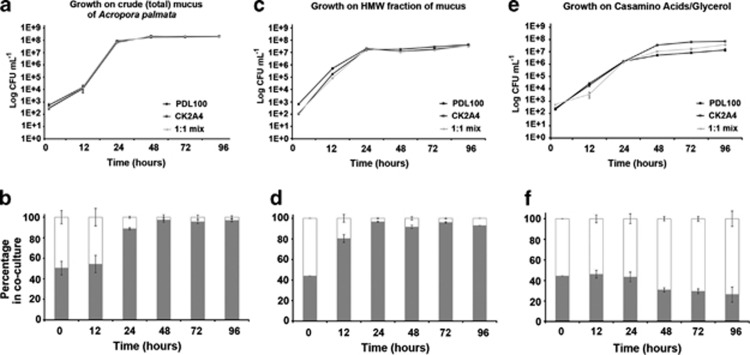Figure 2.
Competitive fitness of S. marcescens PDL100 and CK2A4. To test the importance of catabolic enzymes for growth of S. marcescens on coral mucus, both wild type and CK2A4 were grown both individually and in coculture on mucus of A. palmata and in the HEPES-buffered (10 mℳ, pH 7.1) artificial seawater with casamino acids (0.5 g l−1) and glycerol (0.4% vol/vol). For competition experiments, overnight inocula were serially diluted and mixed (1:1 ratio). Cultures in (a) crude (total) mucus of Acropora palmata, (c) high-molecular-weight (>5 kDa) fraction of A. palmata mucus or (e) casamino acids/glycerol were inoculated at 102 cfu ml−1. Cultures were incubated at 30 °C with shaking. To enumerate cells, at 12, 24, 48, 72 and 96 h cultures were dilution plated onto marine agar supplemented with Tc10. Averages of three biological replications of the experiment (three independent cultures) are shown, error bars are standard error. In monocultures, all strains grew similarly and reached the same final population densities. To estimate the percentage of each strain within each coculture (competitive fitness), colonies were patched onto marine agar supplemented with Tc10 and Gm50 to differentiate between the wild type and the transposon mutant. The relative proportion of the wild type is shown as the gray portion of the stacked column. Competitive fitness experiments were repeated at least twice, and averages are shown (error bars are standard errors). On total mucus (b) and high-molecular-weight fraction of the mucus (d), the mutant was not competitive against the wild type. CK2A4 had a fitness advantage on the casamino acid/glycerol defined medium and grew to higher population densities than wild type and the 1:1 coculture (f).

